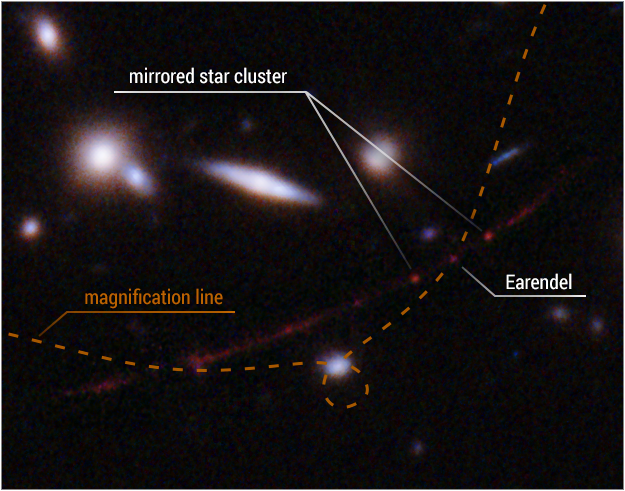PORTLAND, Ore. (KOIN) — They say a picture is worth a thousand words, but according to OMSI, a new record-breaking image captured by NASA’s Hubble Space Telescope is worth billions of years of knowledge.
NASA announced Hubble had crossed a new benchmark Wednesday after the telescope detected light from the furthest individual star ever spotted.
Scientists believe the newly detected star, now named Earendel, would have been 50 times bigger than our sun and “existed within the first billion years after the universe’s birth in the big bang,” according to NASA.
OMSI Director of Space Science Education Jim Todd told KOIN 6 News that although the light detected is from a star that undoubtedly no longer exists, the exciting image of the past contains major implications for the scientific community moving forward.
“We’re looking back in time,” Todd explained. “Lightspeed is 186,000 miles per second, so when we see the light coming from this section of the universe, we are looking at something 12.9 billion years ago, which is now reaching Earth.”
Todd said gravitational lensing used by NASA to magnify the image is perhaps the only way scientists were able to detect an object so far away.
According to NASA, the previous furthest star on record was detected by Hubble in 2018 and existed when the universe was roughly 30% of its current age.
Comparatively, the agency said this newest discovery marks an even larger leap back in time, as the image of Earendale shows the star as it appeared when the universe was only at 7% of its current age.
Likening the captured image to a book, Todd said the light from Earendale is just the first chapter.
“What we’re looking at is a star that’s just beginning to develop, but we’re not even close to the last chapter,” Todd said. “For all we know that star is not there anymore -It probably exploded. So, we are seeing the beginning of time in this picture, it’s a window to the past.”
Todd said this image and further exploration of stars from time past, could inch scientists closer to unraveling some of the earth’s largest questions.
“We are always looking for evidence of the evolution of stars and the universe, to try and capture that process,” Todd said. “We try to look back as far as we can but have never seen something from this time period before. Hubble captured this and in comparison, we haven’t seen anything like it.”

Todd explained the red-colored hue that appears in the image of Earendel is an indication of the age and distance of the star.
Based on the red color captured in the Hubble images, Todd said he believes the picture shows the star cluster nearing the ever-expanding edge of the universe.
“When you see a lot of red, you are looking at something that is just at the front edge,” Todd explained. “It’s moving away from us as the universe expands. We’re never going to be able to see to the boundary of the universe, so we’re only capturing what is actually right there.”
Todd said the gravitational lensing used in this discovery is pushing Hubble to its limits. However, the advantages and insight provided by the new technology will help scientists continue to broaden the boundaries of how far we can look back into the past.
“As a next step, James Webb has already agreed to look at this area in June,” Todd explained. “They plan to look at this, and hopefully see even more than what Hubble is capable of.”
While Todd told KOIN 6 News that discoveries such as the recent finding of Earendel will never complete the entire picture, he said they help scientists expand our knowledge and understanding of our own universe.
“We continue to try to look as far back as we possibly can, and we’re now seeing evidence which gives us some ideas about the formation of the universe and stars,” Todd said. “We haven’t completed the story of this particular finding and we’re going to learn more with James Webb, but this is a major indication of how far we have come in the last 50 years.”
He continued, “And in turn, it will give us a better understanding of how we got where we are; our own sun, our own solar system. So, we can make a better prediction of what’s going to happen in the future.
